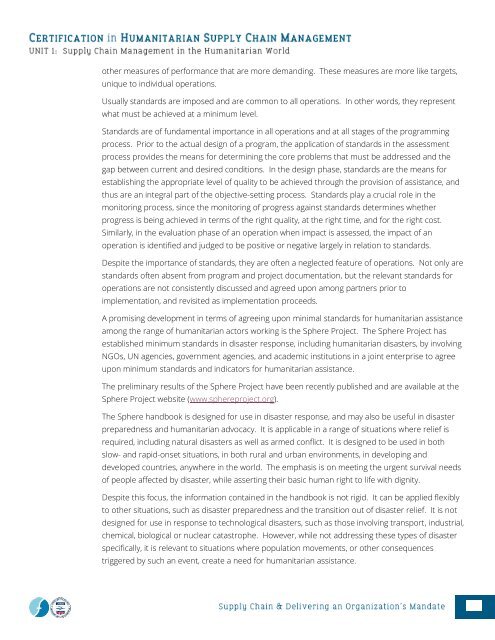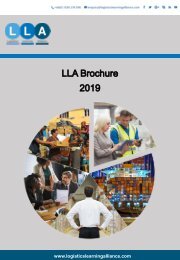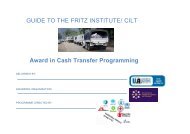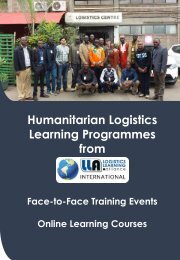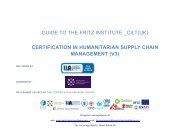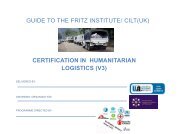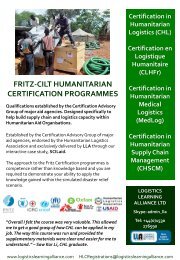CHSCM 3.0 - Unit 1 - SCM in the Humanitarian World
Learning Materials for Unit 1 of the Certification in Humanitarian Supply Chain Management (CHSCM).
Learning Materials for Unit 1 of the Certification in Humanitarian Supply Chain Management (CHSCM).
You also want an ePaper? Increase the reach of your titles
YUMPU automatically turns print PDFs into web optimized ePapers that Google loves.
o<strong>the</strong>r measures of performance that are more demand<strong>in</strong>g. These measures are more like targets,<br />
unique to <strong>in</strong>dividual operations.<br />
Usually standards are imposed and are common to all operations. In o<strong>the</strong>r words, <strong>the</strong>y represent<br />
what must be achieved at a m<strong>in</strong>imum level.<br />
Standards are of fundamental importance <strong>in</strong> all operations and at all stages of <strong>the</strong> programm<strong>in</strong>g<br />
process. Prior to <strong>the</strong> actual design of a program, <strong>the</strong> application of standards <strong>in</strong> <strong>the</strong> assessment<br />
process provides <strong>the</strong> means for determ<strong>in</strong><strong>in</strong>g <strong>the</strong> core problems that must be addressed and <strong>the</strong><br />
gap between current and desired conditions. In <strong>the</strong> design phase, standards are <strong>the</strong> means for<br />
establish<strong>in</strong>g <strong>the</strong> appropriate level of quality to be achieved through <strong>the</strong> provision of assistance, and<br />
thus are an <strong>in</strong>tegral part of <strong>the</strong> objective-sett<strong>in</strong>g process. Standards play a crucial role <strong>in</strong> <strong>the</strong><br />
monitor<strong>in</strong>g process, s<strong>in</strong>ce <strong>the</strong> monitor<strong>in</strong>g of progress aga<strong>in</strong>st standards determ<strong>in</strong>es whe<strong>the</strong>r<br />
progress is be<strong>in</strong>g achieved <strong>in</strong> terms of <strong>the</strong> right quality, at <strong>the</strong> right time, and for <strong>the</strong> right cost.<br />
Similarly, <strong>in</strong> <strong>the</strong> evaluation phase of an operation when impact is assessed, <strong>the</strong> impact of an<br />
operation is identified and judged to be positive or negative largely <strong>in</strong> relation to standards.<br />
Despite <strong>the</strong> importance of standards, <strong>the</strong>y are often a neglected feature of operations. Not only are<br />
standards often absent from program and project documentation, but <strong>the</strong> relevant standards for<br />
operations are not consistently discussed and agreed upon among partners prior to<br />
implementation, and revisited as implementation proceeds.<br />
A promis<strong>in</strong>g development <strong>in</strong> terms of agree<strong>in</strong>g upon m<strong>in</strong>imal standards for humanitarian assistance<br />
among <strong>the</strong> range of humanitarian actors work<strong>in</strong>g is <strong>the</strong> Sphere Project. The Sphere Project has<br />
established m<strong>in</strong>imum standards <strong>in</strong> disaster response, <strong>in</strong>clud<strong>in</strong>g humanitarian disasters, by <strong>in</strong>volv<strong>in</strong>g<br />
NGOs, UN agencies, government agencies, and academic <strong>in</strong>stitutions <strong>in</strong> a jo<strong>in</strong>t enterprise to agree<br />
upon m<strong>in</strong>imum standards and <strong>in</strong>dicators for humanitarian assistance.<br />
The prelim<strong>in</strong>ary results of <strong>the</strong> Sphere Project have been recently published and are available at <strong>the</strong><br />
Sphere Project website (www.sphereproject.org).<br />
The Sphere handbook is designed for use <strong>in</strong> disaster response, and may also be useful <strong>in</strong> disaster<br />
preparedness and humanitarian advocacy. It is applicable <strong>in</strong> a range of situations where relief is<br />
required, <strong>in</strong>clud<strong>in</strong>g natural disasters as well as armed conflict. It is designed to be used <strong>in</strong> both<br />
slow- and rapid-onset situations, <strong>in</strong> both rural and urban environments, <strong>in</strong> develop<strong>in</strong>g and<br />
developed countries, anywhere <strong>in</strong> <strong>the</strong> world. The emphasis is on meet<strong>in</strong>g <strong>the</strong> urgent survival needs<br />
of people affected by disaster, while assert<strong>in</strong>g <strong>the</strong>ir basic human right to life with dignity.<br />
Despite this focus, <strong>the</strong> <strong>in</strong>formation conta<strong>in</strong>ed <strong>in</strong> <strong>the</strong> handbook is not rigid. It can be applied flexibly<br />
to o<strong>the</strong>r situations, such as disaster preparedness and <strong>the</strong> transition out of disaster relief. It is not<br />
designed for use <strong>in</strong> response to technological disasters, such as those <strong>in</strong>volv<strong>in</strong>g transport, <strong>in</strong>dustrial,<br />
chemical, biological or nuclear catastrophe. However, while not address<strong>in</strong>g <strong>the</strong>se types of disaster<br />
specifically, it is relevant to situations where population movements, or o<strong>the</strong>r consequences<br />
triggered by such an event, create a need for humanitarian assistance.


